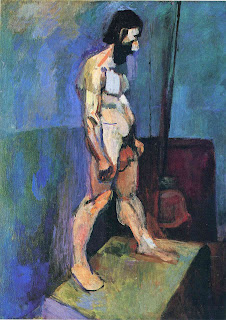The work I selected at the MOMA is by the American artist
Lee Bontecou, Untitled 1961. This piece is my favorite work in the MOMA. I
would consider this piece a wall-hanging, abstract sculpture It is made of welded steel, canvas, black fabric,
rawhide, copper wire, and soot.. Using simple materials, she creates an
ominous, geological aesthetic that is very elemental and engaging. Bontecou
uses neutral, monochromatic earth tones and black calling to mind combat fatigues or dusty
battle fields. She creates shapes in space using rebar with stretched fabric
over it and each work usually contains a negative “void” somewhere central in the
piece. The mood of her sculptures evokes martial power, the void of cannon
barrels or the mouth of a volcano, and the functional technology of tanks.
There is a sense of foreboding, like an earthquake is about to happen. The
forms she creates are like fractured stone, while simultaneously inferring a
sense of the artificial. This particular work is somewhat rectilinear, almost
as if your television transformed into a large gun or an exhaust vent. I find
it particularly interesting that she can achieve a very technological aesthetic
using the material she uses in this piece.
I shared this piece with my girlfriend, Julia (I had to bribe her with strawberry shortcake). I began by relaying
the information and my interpretations as seen in the first paragraph above.
She prompted me with some questions afterward: “Who were her contemporaries?
Why is her work so dark?” In finding the answers to these questions I also
gained more insight into the artist.
Her work is heavily influenced by the effects of World War
II, in which both her parents participated. This work was also created in the
1960’s which was a time of duress and possible wars in Vietnam
and Cuba . It
probably looked like the whole world was going to war again at that time. This
is the climate in which Ms. Bontecou created this work, which is evident in the
mood of the piece.
Her contemporaries in New York
at the time included Jackson Polluck (Abstract Expressionism), Andy Warhol (Pop
Art), and Dan Flavin (Minimalism). The artistic movements that these artists
participated in were all happening during the time when she created this work.
I think you can see evidence of these movements in this work, especially
Minimalism and the brooding, primal emotion of Expressionism.
Julia commented that the voids in Lee Bontecou’s work looked
like bullet holes. In response to my impression that there was an ominous
feeling to the work and that something was about to happen, she felt that the
action had “already happened, this is the aftermath, it had already exploded.” I
found these responses interesting.
The experience of “teaching” this work was rewarding. I was
prompted to find out more personal information about the artist; what drove her
to create the work that she did? Why does the piece evoke dark emotions and
unease? I was able to get a different perspective on the work in terms of
emotional impressions and mood. I found it easy to communicate my own
perspective and the visual analysis of the work. I liked the interaction and
conversation revolving around the interpretation of this piece. It was more
difficult to find out and communicate facts and background of the artist, in
particular because Lee Bontecou rarely comments on her own work. Those aspects
involved a little extrapolation and assumptions on my part, which gave me less
confidence in relaying them. It was also challenging to fill in the missing
information from my initial assessment “on the fly” (i.e. hurriedly searching
on the internet). I learned how important it is to have all the information at
hand and to anticipate potential questions in your preparations.
(Some other MOMA shots below)






I love that your girlfriend asked you hard questions, and that that made you dig deeper into the artists life. Teaching is also learning!
ReplyDelete